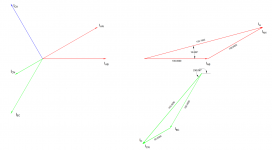Yes, vector math is required to get an exact answer from combining the balanced 3-phase load with the additional single phase load on A-N-C. But your method of simply adding the magnitudes of the currents gives you an overestimate that is not too far over, so usually pretty good for practical purposes. For the exact answer:
Referring to the diagram below, let's call Ia, Ib, Ic, and In the line currents. And that unlabeled crossing point of the two axes, let's call that O for origin; it's the center of the triangle.
Now, what is a 100A resistive 3 ph load? From your proposed answer, I infer that it's connected A-B-C and the line currents from it alone are Ia = Ib = Ic = 100A. [As opposed to 3 separate 100A 2-wire loads connected A-B, B-C, and C-A, which would give you line currents of Ia = Ib = Ic = 100*sqrt(3) = 173A via the usual vector math.] Each line current as a vector points from O to the node A, B, or C (or the opposite direction, but let's go with this convention). That's the direction you get when you add two equal magnitude vectors, each one parallel to a different side of the triangle.
Looking just at the 1ph loads, the usual non-vector math gives you Ia = 100A, Ic = 50A, and In = 50A. And those vectors will all point parallel to the line A-N-C. So for the final answer, we just need to combine the single phase and 3 phase loads.
Ib = 100A and In = 50A are easy, as they have only a 3 phase or single phase contribution, respectively. But to calculate Ia (or Ic), we need to add a vector pointing from O to A (or from O to C) with a vector pointing from N to A (or N to C). Those vectors are 30 degrees apart. We can use the law of cosines: if plane vectors X and Y are at angle D to each other, then | X+Y |^2 = |X|^2 + |Y|^2 + 2 |X| * |Y| * cos D.
So Ia = sqrt(100^2 + 100^2 + 2*100*100*cos 30) = 193A
And Ic = sqrt(100^2 + 50^2 + 2*100*50*cos 30) = 145A
Not so far from the simple approximation.
Cheers, Wayne



